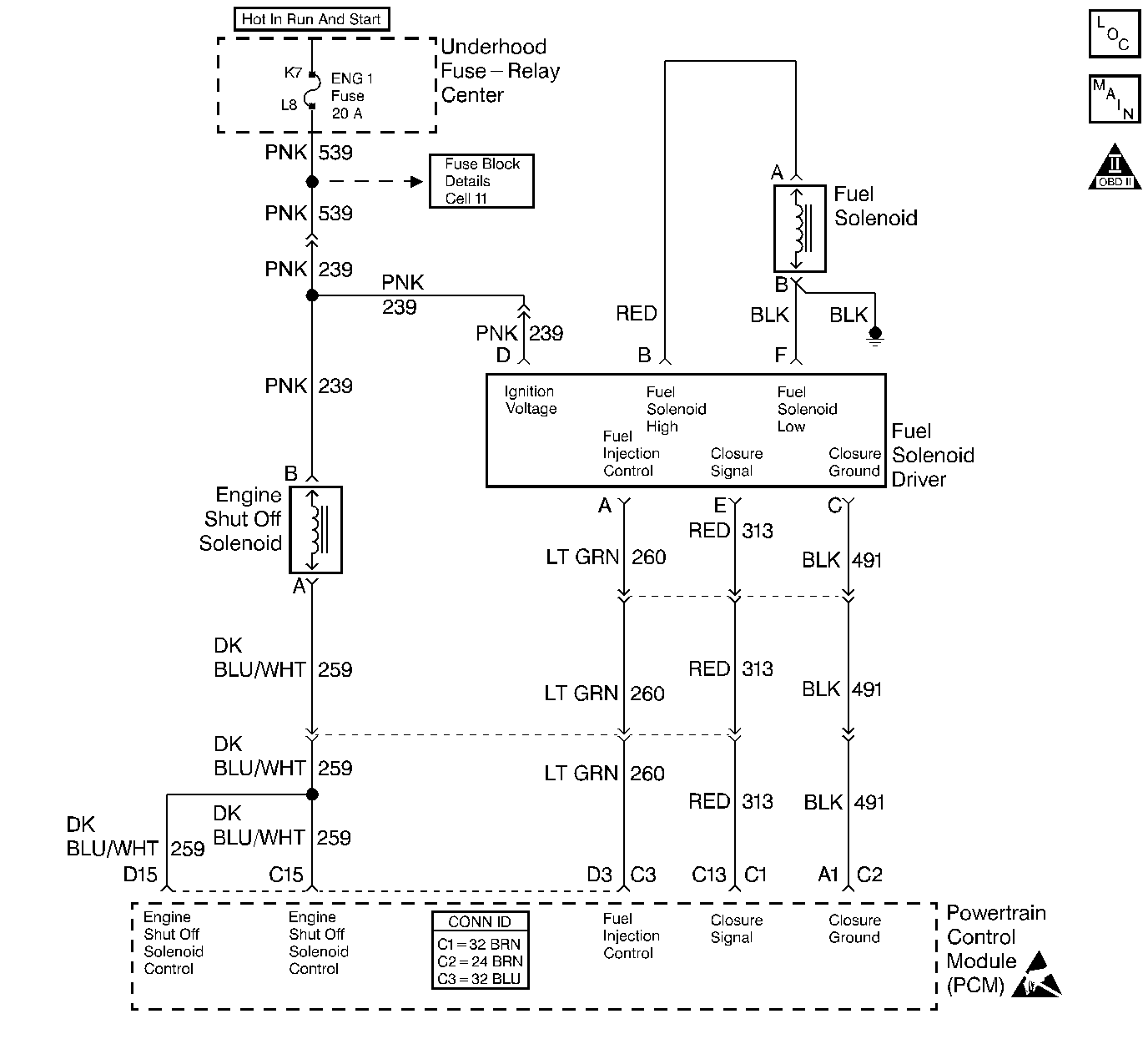
Circuit Description
The Fuel Solenoid Driver is a high current switch which receives inject commands from the PCM. The Fuel Solenoid Driver energizes and de-energizes the fuel control solenoid at precise intervals to achieve accurate control of fuel delivery at all throttle positions and speeds. The Fuel Solenoid Driver supplies ignition voltage to the fuel control solenoid. The Fuel Solenoid Driver also contains circuitry enabling it to sense poppet valve closure (closure time), this information is transmitted back to the PCM. If ignition voltage is low, either through poor connections, charging system failure or low batteries, after market add-ons, it is possible that a slow closure time will occur. The Fuel Solenoid Driver is located on the right side of the injection pump as viewed from the front of the vehicle. The Fuel Solenoid Driver utilizes a closure ground circuit, an ignition voltage circuit, a fuel inject control circuit and a closure signal circuit.
Diagnostic Aids
Important: Since it is difficult to diagnosis intermittent conditions, it is critical that every step of the diagnostic table be performed with thoroughness. Since many other failures can cause similar symptoms to that of a failed Fuel Solenoid Driver, the elimination of other simpler causes of the failure should be eliminated before a Fuel Solenoid Driver is replaced.
It is also important to perform visual checks for a pinched harness (at the intake manifold and turbocharger), and for proper wiring connections at the engine connector.The Fuel Solenoid Driver can be visually checked for an obvious failure. A shorted Fuel Solenoid Driver may cause a the ENG 1 fuse to fail. This type of failure can be associated with a No Start concern. Possible Symptoms of a Fuel Solenoid Driver Are as follows:
| • | No starts. |
| • | Stalling |
| • | Fish Bite (intermittent stumble) |
| • | Surge |
An intermittent can be caused by the following:
| • | Poor connections |
| • | Rubbed through wire insulation |
| • | Broken wire inside the insulation |
Test Description
Number(s) below refer to the step number(s) on the Diagnostic Table.
-
This step will check the ground wire on the injection pump (wire located on top of pump).
-
This step will determine if proper voltage is going to the fuel solenoid driver.
Step | Action | Value(s) | Yes | No |
|---|---|---|---|---|
1 |
Important: Before clearing DTC(s) use the Scan Tool Capture Info to record freeze frame and failure records for reference, as data will be lost when Clear Info function is used. Did you perform the Powertrain On-Board Diagnostic (OBD) System Check? | -- | ||
2 | Check for proper condition of batteries. Refer to Engine Electrical. Is the condition of batteries OK? | -- | ||
3 | Check for adequate fuel in the tank. Is the fuel at an adequate level? | -- | ||
4 | Check the quality of the fuel. Is the fuel quality OK? | -- | ||
5 | Check the Injection Pump Timing. Refer to Fuel Injection Pump Timing Adjustment . Is injection timing OK? | -- | ||
6 | Check for the proper cranking speed. Refer to Engine Electrical. Is the cranking speed OK? | -- | ||
7 | Check for a restriction in the fuel return system. Refer to Fuel Return System Diagnosis . Does the fuel return system operate properly? | -- | ||
Check the injection pump ground wire (located on top of the injection pump). Is the ground OK? | -- | |||
9 | Check for air in the fuel system. Refer to Fuel Feed Pipe and Return Pipe Purging Is there any air in the fuel system? | -- | ||
10 | Check for a proper conection or corrsion in the fuel solenoid closure ground circuit. Did you perform a repair? | -- | ||
11 | Check for a proper conection or corrsion in the fuel inject circuit. Did you perform a repair? | -- | ||
Is voltage at the specified value (during the complaint)? | B+ | |||
13 | Check for a proper conection or corrsion in the fuel connector at the injection pump. Did you perform a repair? | -- | ||
14 | Check for a proper conection or corrsion in the engine and vehicle ground circuits (located at rear of intake manifold). Did you perform a repair? | -- | ||
15 |
| -- | ||
16 | Replace Fuel Solenoid Driver. Refer to Fuel Solenoid Driver Replacement . Is the action complete? | -- | -- | |
17 | Make the appropriate repairs. Is the action complete? | -- | -- | |
18 | Verify condition has been repaired. Is the action complete? | -- | Injection Syetem OK | Go to Driveability Symptoms |
